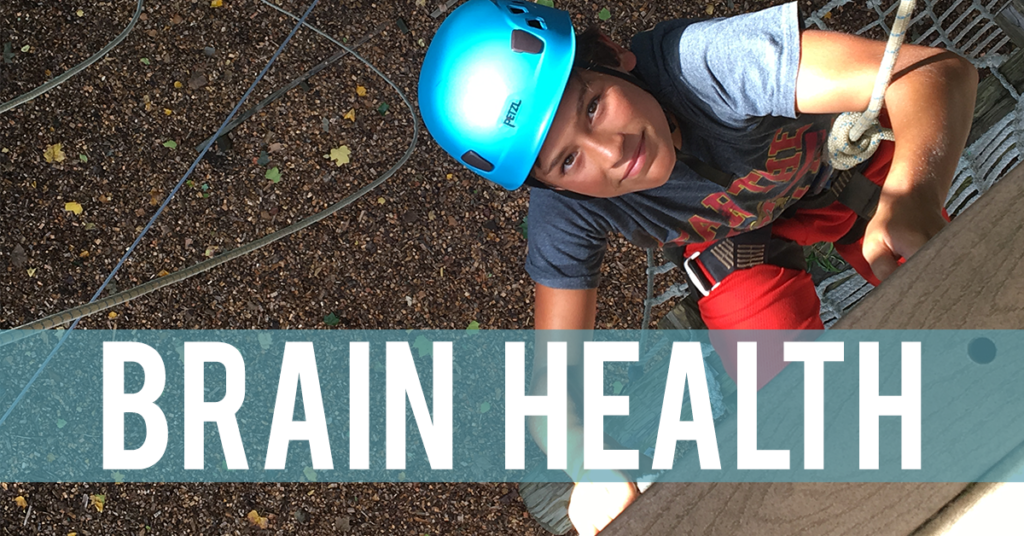We all know that exercise is good for the body. But did you also know that physical activity can also be good for the mind? “There is also a growing body of literature suggesting that physical activity has beneficial effects on several mental health outcomes,” says Dr. Amika Singh. For adults, this mental health dynamic comes in the form of stress relief. For children, however, the mental benefits of exercise go beyond relaxation. New research shows that exercise enhances “brain function and cognition, thereby positively influencing academic performance,” says Singh.
Exercise and Cognitive Development
“All healthy children are born to climb,” says Dr. Joe Frost, acknowledged as the contemporary father of play advocacy. “Soon after birth, children employ built in natural instincts to seek, see, explore, touch, and move objects and build mental and physical capabilities leading to initial climbing skills.”
School Performance
Children who exercise regularly demonstrate “greater attentional inhibition and cognitive flexibility,” writes Karen Dineen Wagner, MD, PhD. This directly correlates to improved performance in the classroom, says Julie Davis, WedMD.
“Active children do better in class and on tests because exercise seems to lead to larger brain volumes in areas associated with memory and thinking functions, such as behavior and decision-making.”
Attention Span
“Active kids also appear to have better concentration and longer attention spans — being fit helps them stay focused to complete assignments,” writes Davis. This is because “[exercise] seems to change where the brain directs its resources, from areas of the brain that are involved in worrying, for example, and toward areas that are more involved in coordination and focus,” says April Bowling, assistant professor at Merrimack College, explained to Healthline.
This is even true for children with Attention Deficit Hyperactivity Disorder (ADHD). Researchers studied the effects of exercise on children with and without ADHD and found both sets benefited from periods of exercise before taking tests.
“Single bouts of moderate-intensity aerobic exercise may be an additional treatment modality for children with ADHD,” writes Wagner. “Moreover, short bouts of exercise during the school day may be a benefit to children in general.”
Mood
“Exercise releases endorphins, which correlates to a happy child,” said Len Saunders, physical health educator, and author of “Keeping Kids Fit” and “Buddy and Bea.” Physical activity has also been proven to help fight depression in school-age children.
“Youths who were physically active at least 60 minutes per day were also less likely to have depressive symptoms,” writes Wagner. “Lower levels of leisure-time screen use (video game, computer, television) were also associated with lower depressive symptoms in adolescents.”
How Much Exercise Does My Child Need?
“In recent years, concerns about children’s safety, the popularity of video games and computers, and increased academic demands have contributed to the decline in outdoor play for children,” writes Wagner. “Unless children are involved in sports, gymnastics, dance, or similar activities, they have limited involvement in exercise-related activities.”
According to the National Association for Sport and Physical Education (NASPE), children should receive at least one hour of physical activity every day:
- Toddlers: 30 minutes planned physical activity AND 60 minutes of free play.
- Preschoolers: 60 minutes planned physical activity AND 60 minutes of free play.
- School-Age: One hour broken up into bouts of 15 minutes or more.
“Work with your child to discover the types of activities he or she would enjoy most,” suggests Davis. “These can be organized, like joining a swimming club or sports teams, or more casual, like bike riding, jumping rope or simply having fun at a local park with friends before starting homework.”
Terrapin Adventures has something for everyone! Conveniently located in Howard County, Maryland, between Baltimore and Washington DC, Terrapin Adventures has a ropes course specifically designed for children ages 5-10 – our Terrapin Explorer kids’ course. We also offer a number of outdoor adventures that are great for the whole family, like biking, kayaking, caving, and geocaching. Terrapin Adventures is also a fantastic destination for birthday parties and field trips!
Book Your Adventure
If you have any questions, please call Terrapin Adventure at 301.725.1313, or email us at info@terrapinadventures.com to learn more.
Works Cited
- Davis, Julie. “Exercise Boosts Kids’ Brain Health, Too.” WebMD, HealthDay, www.webmd.com/children/news/20180105/exercise-boosts-kids-brain-health-too.
- Dineen Wagner, Karen. “Mental Health Benefits of Exercise in Children.” Psychiatric Times, UBM, www.psychiatrictimes.com/child-adolescent-psychiatry/mental-health-benefits-exercise-children.
- “Exercise and Children: The Benefits.” Healthline, Healthline Media, www.healthline.com/health-news/exercise-benefits-children-physically-and-mentally.
- Frost, Joe L. “Why Children Climb.” Play and Playground Magazine 1 July 2013: n. pag. Print.
- Singh, Amika. “Physical Activity and Performance at School.” Archives of Pediatrics & Adolescent Medicine 166.1 (2012): 49. Web.

